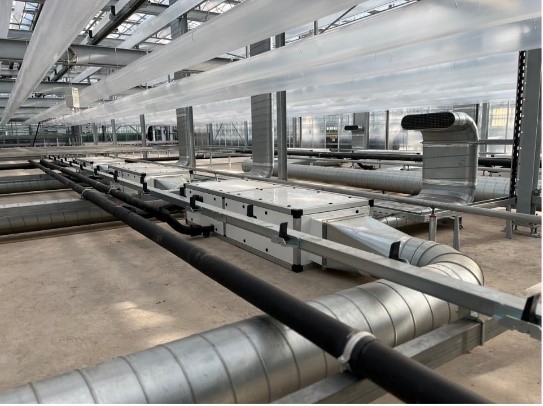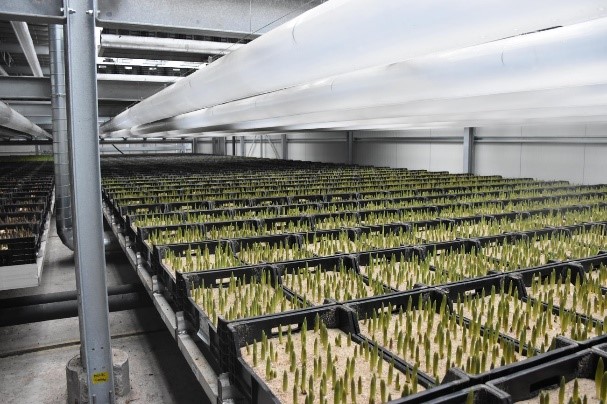
Active dehumidification is the control tool for positively influencing growing conditions, achieving substantial energy savings and also avoiding diseases.
Bosman Van Zaal has been realising customised dehumidification solutions for customers such as WUR Wageningen, Bayer Crop Science, B-Four Agro and Grow-up Farms since 2015.
Our R&D department has now managed to translate these customised solutions into a series of dehumidifiers that are plug-and-play applicable for a wide range of crops and growing systems. Whether in high-tech climate chambers, growing potted plants or fruiting vegetable crops, the innovative OptiDry dehumidifiers can be implemented seamlessly in any cultivation system.
F-gases regulation creates challenges in horticulture
The dehumidifiers used in horticulture typically operate with synthetic refrigerants that contribute significantly to greenhouse gas emissions due to their high GWP (Global Warming Potential).
According to the F-gases regulation EU 2024/573, the sale of dehumidifiers with these refrigerants within Europe will be phased out between 1 January 2025 and 1 January 2030.
This means that service and maintenance of such devices will become uncertain in the future, which may affect operational reliability.
Low-GWP refrigerants are also currently under fire in Europe due to the fact that these refrigerants contain PFAS. As a result, really only natural refrigerants are future-proof. That leaves only 3 applications; CO2, Ammonia and Propane. Of which you can say that for our application propane is the best solution based on the following arguments:
- Energetic in application and capacity range;
- Low working pressures, resulting in little chance of leaks;
- Because of this, traditional cooling system can be used, which has proven reliability;
- With CO2, you go to more complex cooling systems with higher pressures and lower efficiencies in our working and application range; (such a system will always be more expensive, and because of lower efficiencies, you will never earn that back).
- With Ammonia, that doesn’t go together with copper piping and components, and beyond that in our working area/capacity range in combination with direct expansion, it is not to be used.
Bosman Van Zaal sees R290 (propane) as the best and most sustainable solution.
This is the reason why Bosman Van Zaal started a development process for the OptiDry series of dehumidifiers several years ago. These models use the natural refrigerant R290 (propane), which, with a GWP of just 3, barely contributes to the greenhouse effect.
The OptiDry series offers a future-proof solution. Thanks to the use of R290, these dehumidifiers meet all current and future legal requirements. Moreover, R290 has more favourable energetic properties than synthetic refrigerants, resulting in lower energy consumption and operating costs.
With the OptiDry series, you choose a sustainable, efficient and legally compliant solution for dehumidification in horticulture.
OptiDry series: innovation with future perspective
The OptiDry series consists of two basic type dehumidifiers:
- The OptiDry Compact X which are connected to an outdoor unit (chiller or buffer)
The OptiDry Advanced DX (stand-alone dehumidifier, cooling and heating)
The OptiDry Compact X
The OptiDry Compact X is designed to dry air very efficiently and can be easily connected to an existing or new chilled water or freecooling circuit by drycooling or basin water. The X stands for cross flow heat exchanger, which is integrated into the unit. Using this additional heat exchanger saves 30-50% on cooling capacity. The OptiDry Compact X is available in two different versions to suit every growing situation.


The OptiDry Advanced DX
The OptiDry Advanced DX is a compact, efficient unit designed for drying, cooling and heating air in a plug-and-play format. These units can be easily installed in greenhouses or added to existing plant growth chambers for improved dehumidification.
As one of the first dehumidifiers to use natural refrigerant R290 (propane), the OptiDry Advanced DX offers lower energy consumption compared to synthetic refrigerant models. R290 (propane) is therefore not only highly efficient and environmentally friendly, but also future-proof in contrast to synthetic refrigerants.
Key features of the OptiDry range:
- Compact design (only 60 or 80 cm height)
- Lightweight models (from only 105 kg) for easy installation
- High-efficiency dehumidification capacity of up to 4 l/h*KWh
- Environmentally friendly and future-proof refrigerant R-290 (propane)
- Available with airsock for use under cultivation gutters and/or container systems
- OptiDry Advanced DX is also available as a hydroloop version, with which heat can be removed as required via a water circuit. This also allows active cooling or heating, thus allowing active climate control.
- Easy to integrate and connect to new or existing chilled water systems.

For more information, please visit the OptiDry website where both the OptiDry Compact and OptiDry Advanced technical brochure can be downloaded.

Bosman Van Zaal is committed to supporting the horticultural sector with high-quality technology that complies with current and future regulations. ‘With the OptiDry series, growers are able to significantly reduce their energy consumption without having to make concessions on quality or cultivation security, regardless of the crop. Furthermore, we believe it is important to supply the sector with future-proof installations. With its R-290 natural refrigerant, the OptiDry Advanced is not only ready for the future, it is also technically at the top of its field,’ says Edwin Snabel.
